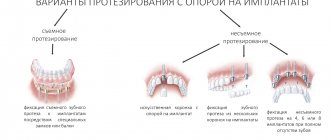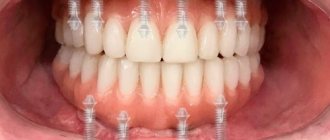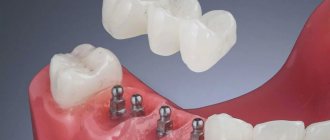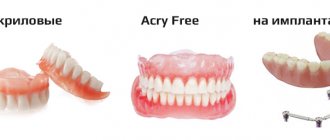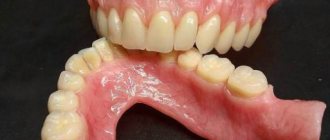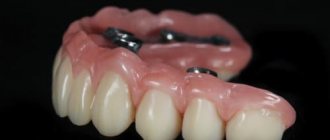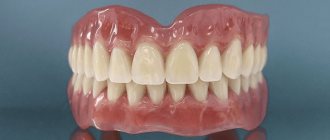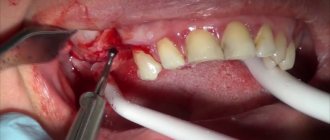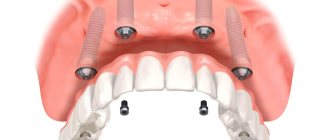Tooth loss can occur for a variety of reasons and under the influence of various factors. Sometimes a person loses several units due to injuries or dental diseases, but there are also cases of complete edentia. Restoration of dental units in the latter version can be carried out using various types of orthopedic structures, but experts recognize implant prosthetics in the complete absence of teeth as the most stable and durable method of restoration.
This procedure has significant differences with the techniques used for the loss of one or more dental units. We will get acquainted in detail with the features of the procedure, options for its implementation and prices for prosthetics on implants in the complete absence of teeth in the following sections of the article.
Calculate the cost of treatment by taking a short test in 20 seconds!
Do not delay your treatment, because in this matter time plays against us.
Complete edentia: possible options for dental prosthetics
If it so happens that the patient is missing all dental units in the oral cavity, then restoration with prosthetics on implants can be carried out using three main methods:
1. Traditional implantation. In this version of the operation, the patient is first implanted with implants, and after their integration with the tissues of the oral cavity, prosthetics is performed with fixed orthodontic structures.
2. Complete removable denture on mini-implants.
3. Conditionally removable prosthesis fixed on implants.
The second option allows you to significantly save your own budget and get excellent results from implant prosthetics at an affordable cost. Mini-implants will firmly hold the prosthesis in your mouth, and its daily use will not cause you the slightest discomfort.
Fixed prosthetics on implants is more difficult and expensive to carry out, but the patient will have the feeling of his own natural teeth in the mouth, and the design itself will be as comfortable as possible for daily use. Moreover, to implement permanent prosthetics on implants in the absence of teeth, it will be enough to implant no more than six artificial roots into the jaw bone.
Conditionally removable prosthetics are suitable for those who wanted to avoid the costs of traditional implantation and at the same time obtain an excellent and stable restoration result in the absence of teeth. Conditionally removable dentures are fixed in the oral cavity so firmly that it is impossible to remove them without the help of a specialist and, of course, they will not fall out during eating or active conversation, they do not need to be removed during the night's rest or after each meal. Below we will consider in detail the options for prosthetics on implants, taking into account the location of the treatment procedures.
Use of mini implants
Mini-implantation is a minimally invasive procedure - it will require the installation of 6 small artificial roots. The main feature of mini-implants is the fact that they are non-separable and differ in their size and installation method. In this case, there is no fixation of the abutment; the crowns or bridge are fixed to the round tip of the mini-root, covered by a rubber ring, which is a kind of lock. Fastening is carried out according to the principle of a button on clothing. Artificial roots are implanted strictly parallel to each other to ensure tight fixation of the prosthesis in the oral cavity. It is worth noting that the load on the structure should be minimal to avoid rejection.
Indications for this technique consist mainly of a narrow alveolar ridge, that is, the impossibility of implanting standard, “large” titanium roots. Carrying out preliminary osteoplastic surgery to increase tissue volume is not suitable for everyone, so this solution is resorted to quite often.
Types of dental prosthetics on implants for the lower jaw
The lower jaw bone has increased thickness and density, and therefore, for prosthetics on implants in this area, a significantly smaller number of artificial dental roots are used - no more than six units. The process of osseointegration in this section of the jaw also occurs at an accelerated pace, over several months.
Removable prosthetics on implants in the complete absence of teeth in the lower jaw involves the use of two to four implants in the procedure. Most often, four implants equipped with attachments (micro-locks) are implanted into the patient. This method of prosthetics on implants in the absence of teeth has a number of advantages:
- Excellent prosthesis fixation rates;
- No need to carry out complex hygienic care procedures;
- The simplicity of the design of the prosthesis, making the price of the procedure as affordable as possible.
Partially removable dental prosthetics on two implants
When prosthetics on implants in the lower jaw area, only two artificial roots with attachments can be used: implantologists resort to this option when there is a clear deficiency of bone tissue for the installation of a larger number of implants. This method of restoration also has some disadvantages, the main of which will be the creation of pressure not only on the implants, but also on the soft tissues of the oral cavity. Such a load causes gradual atrophy of the gums, and in order to avoid such a negative phenomenon, the base of the prosthesis should be changed every six months and the strength of the attachments should also be checked.
Dental prosthetics - all-on-4 (all on four)
Another version of the prosthesis that can be used is a product with a beam-type fastening, for the installation of which in the mouth four titanium roots are first implanted - all-on-4 (all on four). This technique allows you to transfer unwanted load from the jaw to the implants and avoid the negative processes of reducing the volume of natural tissues, as well as obtain the strongest and most stable fixation of a removable denture. The orthopedic design in this case is made of polymer material, and adaptation to it occurs quickly and with a minimum of discomfort, and the prosthesis itself does not require specific care.
Dental prosthetics - all-on-6 (all on six)
Fixed prosthetics on implants is traditionally carried out using six implants, but it is also possible to carry out restoration in the area under consideration using the innovative method - all-on-6 (all on six), which involves installing two implants out of six at an angle of a certain degree. Fixed prosthetics on implants has a number of advantages, including a high level of aesthetics: a permanent prosthesis perfectly imitates natural teeth, and during the period of implant healing, the patient is given a temporary orthopedic structure (if immediate implantation was not carried out).
Implantation with screw fixation
Conditionally removable prosthetics on implants is carried out using structures fixed with screws in the area of manipulation. The denture is fixed so firmly that it can only be removed in a clinic, and this is important for patients who experience psychological discomfort from the fact that removable dentures need to be constantly removed from the mouth for hygiene, at night. Another advantage of conditionally removable prosthetics on implants is that, if necessary, the doctor can easily remove the prosthesis without damaging the structure itself, while other types of orthodontic products will be hopelessly damaged when removed - their integrity will have to be destroyed by sawing.
Contraindications
General contraindications to full implantation are:
- bleeding disorders,
- oncopathology,
- pregnancy,
- childhood,
- mental disorders.
Classical two-stage implantation and implantation according to the ALL ON 4/6 protocols are also not recommended for diabetes, periodontitis, periodontal disease, hepatitis, smoking (patients with these conditions are offered a less traumatic basal technique).
Upper jaw implantation
The bone in the maxillary region has a reduced density and therefore, in order to obtain the most durable fixation of the prosthesis, it is necessary to use a significantly larger number of units of implanted artificial roots - up to eight pieces. The process of integration with the tissues of the human body will also take longer – up to six months.
In removable prosthetics on implants in the absence of teeth, from four to six implants are used. A cover-type prosthesis with spherical attachments is usually fixed on four titanium roots. This type of orthopedic design will completely cover the palate, but if you want to install a prosthesis without a palate, keep in mind that it will be fixed on a significantly larger number of implanted implants, which will of course affect the final price of the procedure.
Dentures without a palate for removable prosthetics on implants in the complete absence of teeth can be fixed using micro-locks, locators, or a beam. The beam will provide maximum fastening strength, but the price of the prosthesis will be equal to the cost of a fixed orthodontic product.
Fixed prosthetics on implants in the complete absence of teeth in the upper jaw requires the preliminary implantation of six to eight implants; all-on-4 technology is also applicable to restore lost dental units. Implants are placed in the upper jaw in the traditional way, which allows you to get the most reliable, stable and durable result in permanent prosthetics on implants with complete edentia. The exact number of implants for the procedure is selected based on the condition of the bone tissue and the structural features of the jaw.
During the healing of the implants, the patient is given a prosthesis made of polymer material, which is subsequently replaced by a permanent structure made of dental ceramics or zirconium dioxide. Prosthetics on implants in the absence of teeth in the upper jaw can also be conditionally removable. In this case, implants with screw fixation in the jaw bone are used.
Why do you need to restore your teeth?
Edentia is not only discomfort, but also early aging. The absence of teeth leads to changes in facial features, sunken cheeks, and the appearance of deep wrinkles. The person looks older, his appearance becomes sickly. In addition to visible imbalances in proportions and a deterioration in the quality of life, when there are no teeth at all, health problems
:
- The diet is reduced, the body does not receive the required amount of vitamins and minerals. The immune system suffers, metabolic processes are disrupted, and cells do not receive enough nutrients.
- Gastrointestinal diseases are provoked. Food is chopped poorly, making digestion difficult. Sometimes patients switch to eating pureed food or pureed food - this method also contributes to the appearance of dysfunction of the stomach and intestines.
- The absence of teeth in the jaws leads to improper distribution of the load on the gums and bone. Tissues atrophy and become thinner.
The bite also changes, diction is impaired - speech is slurred, most sounds are distorted. The absence of teeth affects the emotional state, lowers self-esteem, and the circle of friends narrows. Researchers have also established a direct connection with the presence of teeth and the state of intelligence and activity of older people.
Prosthetics ALL-ON-4 all on 4 (all on four)
This method of implantation was created by specialists from the implant manufacturer - the world famous dental brand Nobel. When carrying out prosthetics on implants in the complete absence of teeth, this method involves the implantation of four implants into one jaw and loading them with a fixed-type prosthesis secured with screws. Implants implanted at the end of the dentition are placed at an angle of forty-five degrees, which helps to avoid affecting complex areas during manipulation: the area where the nerve exits and the maxillary sinus.
At the development stage, the method under consideration was planned to be as gentle as possible for patients, but in order to avoid a minimum of surgical interventions, a sufficient volume of bone tissue and its solid height are required. Without meeting these conditions, it is impossible to implant an implant of the required length into the bone, and shorter structures may simply not take root. In such options, patients are offered a procedure with the installation of not four implants, but six. Two additional implants will ensure uniform load on the natural tissues of the oral cavity and significantly reduce the risk of implant rejection.
Preparation
Implantation is a serious surgical operation with a number of contraindications and the likelihood of complications. With complete edentia, the number of implants installed increases, and the risks increase accordingly. Our task is to minimize possible consequences. Therefore, the procedure is preceded by careful preparation:
- examination, sanitation of the oral cavity;
- treatment of dental diseases;
- collecting anamnesis and examination to assess the patient’s health (blood tests, urine tests, ultrasound of internal organs and consultations with specialized doctors according to indications);
- X-ray, computed tomography of the dentofacial apparatus.
After therapeutic and diagnostic procedures, a treatment plan is drawn up, an installation method and rod model are selected, and computer modeling is performed.
Implantation in the absence of all teeth
Bone grafting: is it always mandatory?
The need for bone grafting arises when the patient has a clear lack of natural bone material - in thickness or height. If this deficiency is small, then it is possible to combine operations and carry out all manipulations simultaneously with prosthetics on implants.
If the lack of natural bone material is pronounced, then before prosthetics on implants a series of manipulations will be carried out to build up the bone material to the required volume and only then the implantation itself. In this case, the restoration process will take a considerable time and may take a year or more.
However, it will be useful to know that in modern dentistry there are techniques that allow you to avoid the mandatory bone grafting procedures before implantation. For example, the restoration of not all dental units, but only up to and including the sixth unit in the dentition of the jaw will allow not to build up the bone in height, since the implants will be placed in the area of the front teeth, in which this indicator is usually normal, as well as in the “ fives." In the future, a permanent prosthesis will be fixed to the implanted roots, and this approach will allow you to obtain an ideal implantation result in terms of aesthetics and functionality without prior bone grafting.
If the height of the bone is normal, but there is a problem with its thickness, then implants of a special design, developed specifically for such cases, can help to do without bone grafting, but in this case it is worth choosing the right artificial roots for implantation. Not all implants from all manufacturers are able to withstand high loads.
FUN FACT: The best way to avoid bone grafting is to not put off restoring your teeth. The longer dental restoration is delayed, the more the jawbone becomes thinner.
What to do if there is not enough bone tissue to implant implants on top
In case of unsatisfactory condition of the bone structures of the upper jaw, a sinus lift procedure (building up the bone to the required volume) is performed before implantation. The essence of the technique lies in raising the bottom of the maxillary sinus and filling the resulting space with biomaterial. The operation can be performed in two ways:
- open;
- closed.
Open includes several stages:
- Gum section.
- Cutting the outer layer of bone using a ball-shaped bur.
- Providing access to the maxillary cavity.
- Gently lifting the bottom of the maxillary sinus.
- Placement of bone material into the resulting space.
- Installation of a protective membrane.
- Stitching.
It takes 5-6 months for the graft to engraft. When the planted biomaterial grows with blood vessels and becomes viable, an implant is implanted into it.
The closed sinus lift technique is indicated for alveolar ridge heights of 7-8 mm. All procedures are performed through a puncture, not a cut. Bone granules are inserted through a miniature hole. The implant is placed immediately after the procedure is completed.
Tips for choosing the type of implants
For prosthetics on implants, products of different types and from various global manufacturers can be used. Artificial roots for implantation are available in a wide range of types and prices, but not all of the implantation systems present on the market have passed the necessary clinical trials and time-tested. In addition, not all implant options are widely used in Russia, which can lead to difficulties if it is necessary to additionally order any components for the system.
When choosing a system for prosthetics on implants in the absence of teeth, you should first consider the options offered by world-famous manufacturers and widely used in modern dentistry. When selecting implants, close attention should be paid to its connection, since the density of the artificial root in the bone and its stability and ability to withstand increased loads depend on this element.
It is also worth studying the data on the material used to manufacture implants. Research shows that the healing process of those structures that are made of pure titanium occurs faster. The more impurities are added to the production material, the longer the process of integrating the implant with the natural tissues of the human body will take. No less important is the type of surface of the implants that will be used during the restoration process.
Each brand manufacturer processes implant surfaces using its own unique technology. Special treatment of the surfaces of implants from some companies makes it possible to ensure and accelerate the process of fusion of the structure with the natural bone material of the human body, and in addition, makes it possible to use implant systems in people suffering from various pathologies of the blood and blood vessels, and autoimmune diseases.
And one more key point: even after studying all the criteria for competently choosing implants for prosthetics, do not make your own choice of system. Only a qualified implantologist can select implants and the procedure method after assessing the clinical picture of a particular case. For detailed advice from a specialist in prosthetics on implants, contact our dentistry in Moscow - Vanstom! Address of our clinic: Moscow, Baumanskaya metro station, st. Bakuninskaya, 17/28.
Calculate the cost of treatment by taking a short test in 20 seconds!
Do not delay your treatment, because in this matter time plays against us.
Nylon or silicone dentures
This type of prosthesis is similar to acrylic, but made from more modern and safe materials. Nylon is softer and more elastic, the prosthesis looks better than acrylic ones, but they are also fixed - not quite reliably. Due to the softness of the system, these dentures will not allow you to chew food well; in addition, they load the gums in this way, which over time leads to atrophy of the jaw bone tissue.
Nylon dentures have the following advantages: the absence of allergic reactions, due to the absence of pores in the material, they do not absorb moisture and odors, getting used to them is faster than acrylic ones, they do not rub the gums, are practically invisible to others and have antimicrobial properties.
The disadvantages include: uneven load distribution, short lifespan (3-4 years) and impossibility of repair, high price compared to acrylic ones. Another disadvantage is the problem of a massive base, which, covering the entire palate, causes problems with diction. The elasticity of the nylon prosthesis material is also its disadvantage. Due to the flexible base, the load during chewing is transferred only to the area where food is currently being chewed, this leads to accelerated atrophy of bone tissue.
Cost of prosthetics for complete absence of teeth
The price of prosthetics with implants if all teeth are missing is not cheap, but it is fully justified by its results: aesthetics, reliability, durability. Titanium roots can serve for many years without losing useful characteristics, so all costs for prosthetics will be covered. In addition, the implantation procedure is carried out in several stages and is also paid for - payment is made separately for each stage, which makes it possible to calculate and plan upcoming costs.
The final cost of the service for the patient will be influenced by a significant number of different factors, including: the type of orthodontic product, the material of its production, the type of implant, the manufacturer of the implantation system, the method of prosthetics, the need for additional therapeutic procedures before prosthetics. Having considered all the factors in determining the price of prosthetics on implants and taking into account all the features of a specific clinical case, it is always possible to choose the implantation option that will suit the patient in terms of quality, price and result.
However, remember - the price of implantation should not be a fundamental factor if you want to receive a service of decent quality. Neither the implants themselves nor the services of an implantologist can cost a penny, since the procedure is complex and requires the use of expensive consumables and equipment. Therefore, we advise you to contact not those clinics that attract patients with low prices in their price lists, but dentists that offer fair prices for implantation. In our dentistry in Moscow, Vanstom, you can get high-quality dental services at real prices! Come to our clinic: we are located next to the Baumanskaya metro station, in the center of the capital.
